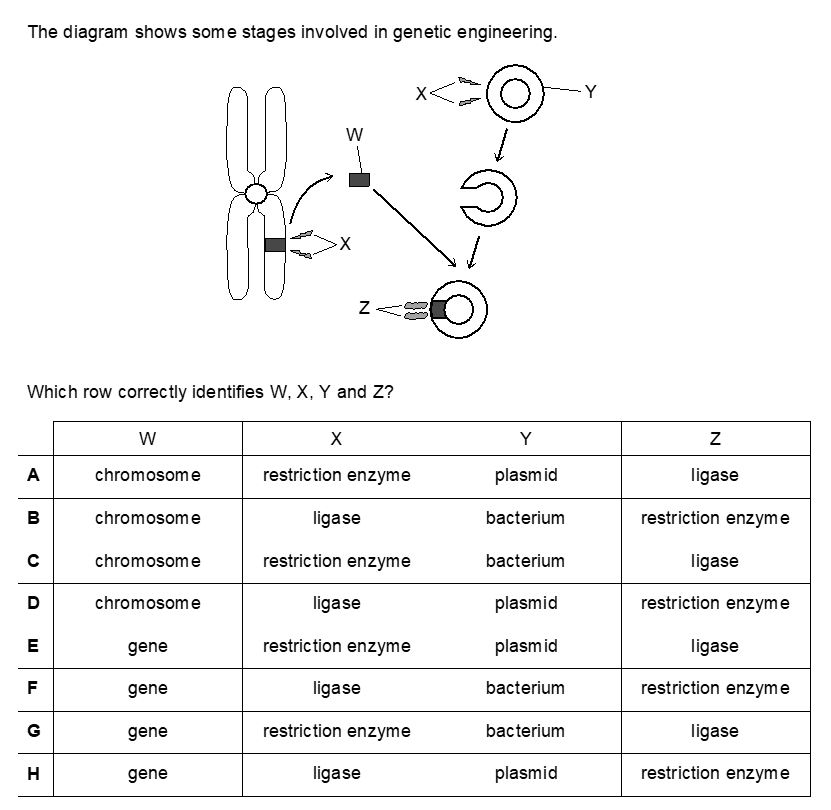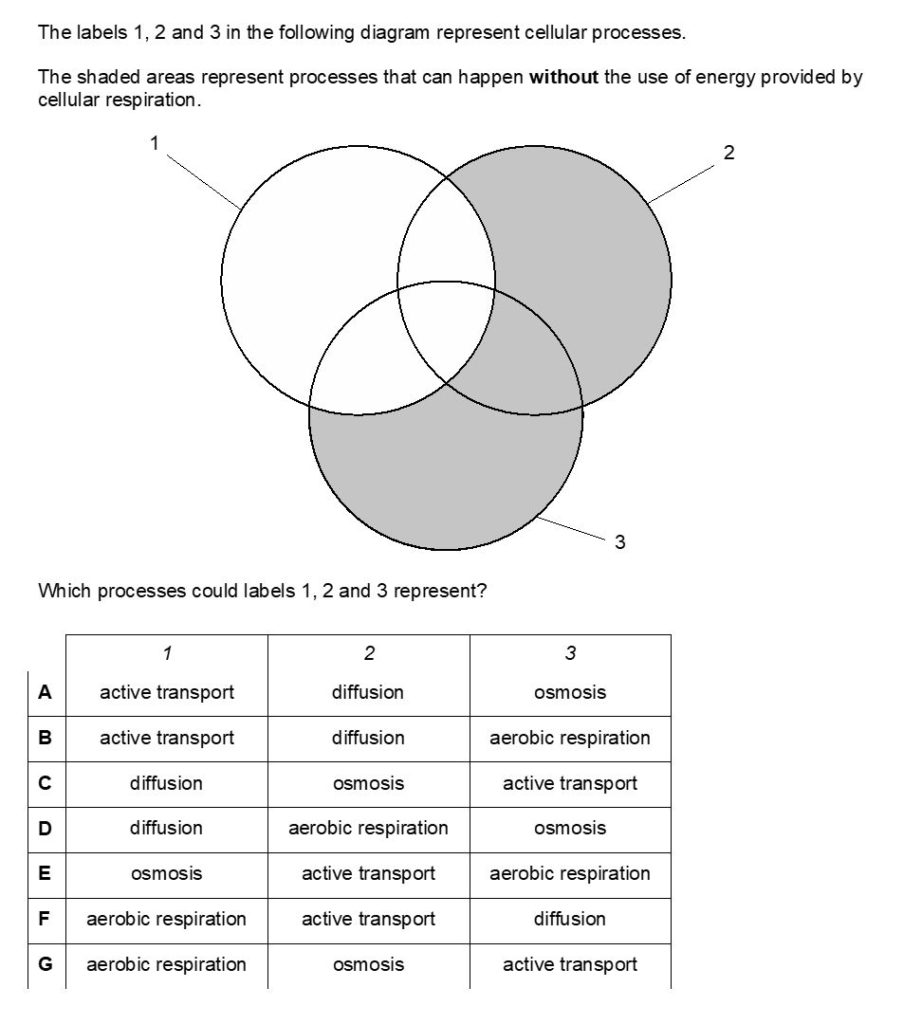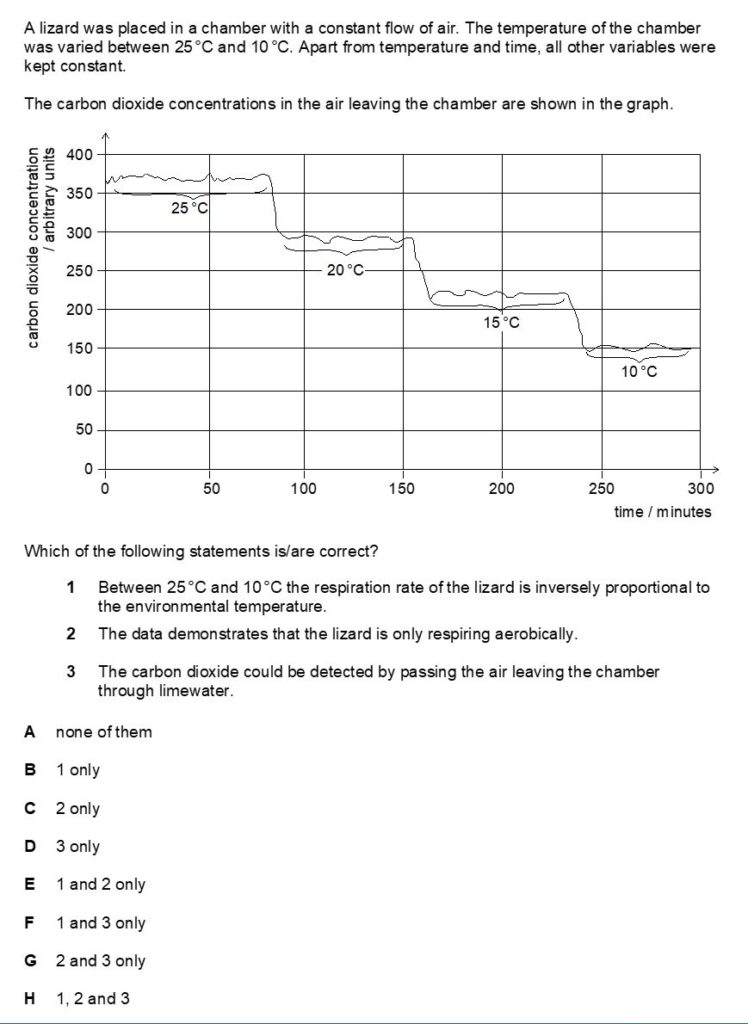‘Scientific Knowledge and Applications’ is Section 2 of the BMAT.
This section will test the scientific and mathematical knowledge you have covered whilst at school. The examiners are testing at your ability to apply this knowledge. The BMAT specification covers knowledge up to GCSE level.
However, don’t fall into the trap of thinking that, as the specification only covers GCSE level knowledge, you’ll be able to breeze through.
The format of the questions are often framed in a different way to questions at GCSE and A-level – and you won’t have access to a calculator. As you will be applying for an academically challenging undergraduate biomedical degree course the BMAT is used to assess your ability to do well in these areas.
Your university studies will be based on the topics of Biology, Chemistry, Physics and Mathematics therefore it is important that you have the appropriate level of knowledge in these areas. As a large number of candidates will have achieved highly thus far in their studies, the BMAT is intended to be of a challenging nature in order for universities to differentiate you effectively.
In this post we’ll go through the ENTIRE BMAT Biology specification (in case your particular exam board didn’t cover any topics), do some worked practice questions and give you some top tips.
Table Of Contents
- Number of questions in BMAT section 2
- BMAT Section 2 Time Pressure
- BMAT Section 2: Biology Specification
- How To Revise For Each BMAT Topic
- BMAT Section 2 Question & Answer Types
- Fully Worked BMAT Biology Questions & Answers
- BMAT Section 2 Scoring For Biology Questions
- Closing Tips For The BMAT Biology Section
Number of questions In BMAT Section 2
In section 2 there are a total of 27 multiple-choice type questions. They will test you on the topics of Biology, Chemistry, Physics and Mathematics and the number of questions for each topic is shown in the table below.
| Topic | Number Of Questions |
|---|---|
| Biology | 7 |
| Chemistry | 7 |
| Physics | 7 |
| Mathematics | 6 |
| Total | 27 |
BMAT Section 2 Time Pressure
Section 2: Biology is designed to test your ability to answer questions under time pressure; therefore you will need to become familiar with these types of conditions.
You should also get used to analysing data quickly and deciphering exactly what the questions are looking for. Revising core concepts well will help you to answer questions more efficiently.
Furthermore, you should become comfortable doing calculations without using a calculator.
On the day there will be the added pressure of a new and stressful environment therefore becoming familiar with exam conditions like this will be a highly beneficial experience.
You could perhaps ask one of your teachers to set a mock exam for you, especially if some of your colleagues are also sitting the BMAT.
BMAT Section 2: Biology Specification
Examinable content is shown below and has been adapted from Cambridge Assessment Admission Testing’s BMAT Content Specification.
Just click the topic to see the full specification.
| B1.1 | Know and understand the structure and function of the main sub-cellular components of both animal and plant eukaryotic cells to include: a. Cell membrane b. Cytoplasm c. Mitochondrion d. Cell wall (plant only) e. Chloroplast (plant only) f. Vacuole (plant only) |
| B1.2 | Know and understand the structure and function of the main sub-cellular components of prokaryotic cells (bacteria) to include: a. Cell membrane b. Cytoplasm c. Cell wall d. Chromosomal DNA/no ‘true’ nucleus e. Plasmid DNA |
| B1.3 | Know and understand the levels of organisation as: cells to tissues to organs to organ systems |
| B2.1 | Know and understand the processes of diffusion, osmosis and active transport, including examples in living and non-living systems |
| B3.1 | Mitosis and the cell cycle: a. Know and understand that the cell cycle includes interphase (the cell grows and DNA is copied) and mitosis (division leading to two daughter cells that have the same number of chromosomes so are genetically identical to each other and the parental cell) b. Know and understand the role of mitosis in growth by increasing cell numbers, repair of tissues, replacement of worn out cells and asexual reproduction c. Understand that cancer is the result of changes in cells that lead to uncontrolled growth and division |
| B3.2 | Meiosis and the cell cycle a. Know and understand the cell cycle includes interphase (the cell grows and DNA is copied) and meiosis (division that produces daughter cells, known as gametes, in which the chromosome number is halved from diploid to haploid so they have a single set of chromosomes). Each daughter cell will be genetically different b. Know and understand the role of meiosis in reducing the chromosome number and that the full chromosome complement is restored at fertilisation |
| B3.3 | Asexual and sexual reproduction: a. Know and understand that asexual reproduction involves one parent and that offspring are genetically identical when no mutations occur b. Know and understand that sexual reproduction involves two parents and that offspring are genetically different in relation to each other and the parents, leading to (increased) variation |
| B3.4 | Sex determination: a. Know that, in most mammals including humans, females are XX and males are XY b. Be able to establish the sex and ratio of offspring using genetic diagrams |
| B4.1 | Know the nucleus as a site of genetic material/chromosomes/genes in plant and animal cells |
| B4.2 | Know and understand the following genetic terms: a. Gene b. Allele c. Dominant d. Recessive e. Heterozygous f. Homozygous g. Phenotype h. Genotype i. Chromosome |
| B4.3 | Monohybrid crosses: a. Use and interpret genetic diagrams to depict monohybrid (single gene) crosses b. Use family trees/pedigrees c. Express outcome as ratios, numbers, probabilities or percentages d. Understand the concept of inherited conditions e. Know that most phenotypic features are the result of multiple genes rather than a single gene inheritance |
| B5.1 | Understand that: a. The genome is the entire genetic material (DNA) of an organism b. Chromosomes contain DNA |
| B5.2 | Describe the structure of DNA: a. Know that DNA is a polymer made up of two strands forming a double helix b. Know that DNA is made from four different nucleotides, each consisting of a common sugar and phosphate group along with one of four different bases attached to the sugar c. Know the complementary pairs of bases – adenine (A) with thymine (T), guanine (G) with cytosine (C) – and that the sequence of these bases is the genetic code |
| B5.3 | Protein synthesis: a. Know and understand that genes carry the code for proteins b. Know and understand that the genetic code is ‘read’ as triplets, and that each triplet codes for an amino acid c. Understand that protein synthesis involves the production of proteins from amino acids |
| B5.4 | Gene mutations: a. Understand that a mutation is a change in the DNA b. Know that most mutations have no effect on the phenotype, some will have a small effect, whilst occasionally others will determine the phenotype |
| B6.1 | Genetic engineering: a. Understand the process of genetic engineering to include: i. Taking a copy of a gene from (DNA/chromosomes of) one organism ii. Insertion of that gene into the DNA of another organism iii. The roles of restriction enzymes and ligases b. Recall examples of genetic engineering in different cell types c. Explain the benefits and risks of using genetic engineering in medical applications |
| B6.2 | Stem cells: a. Know that embryonic stem cells can give rise to any cell type b. Know that cells lose this ability as an animal matures c. Know the functions of stem cells including adult stem cells d. Explain the benefits and risks of using stem cells in medical applications |
| B6.3 | Selective breeding: a. Understand the impact of selective breeding on domesticated animals |
| B7.1 | Natural selection and evolution: Know that there is usually extensive genetic variation within a population of a species b. Describe evolution as a change in the inherited characteristics of a population over time through a process of natural selection which may result in the formation of a new species c. Explain how evolution can occur through natural selection of variants that give rise to phenotypes best suited to their environment d. Understand antibiotic resistance and that it is an example of evolution through natural selection |
| B7.2 | Sources of variation e. Understand that variation can be genetic/inherited, resulting in a range of phenotypes f. Understand that variation can also be environmental, which affects a range of phenotypes |
| B8.1 | Understand that enzymes are biological catalysts |
| B8.2 | Understand the mechanism of enzyme action including the active site and enzyme specificity |
| B8.3 | Understand the factors affecting the rate of enzyme action: a. Temperature b. pH |
| B8.4 | Know the role of the amylases, proteases and lipases in digestion |
| B9.1 | Respiration: a. Understand the process of cellular respiration b. Understand the process of aerobic respiration, including the word equation c. Understand the process of anaerobic respiration in animals, including the word equation |
| B9.2 | Organ systems: a. Nervous system: i. Understand that the central nervous system comprises the brain and spinal cord ii. Explain the structure and function of sensory neurones, relay neurones, motor neurones, synapses and the reflex arc b. Respiratory system: i. Explain the structure and function of the respiratory (breathing) system, including the structure of the thorax ii. Understand the processes of ventilation and gas exchange iii. Understand the importance of a high surface area: volume ratio for the gas exchange process c. Circulatory system: i. Understand the structure and function of the circulatory system, including the heart, heart rate and ECGs, and the blood vessels (arteries, veins and capillaries) ii. Understand the composition and function of the blood (red blood cells carry oxygen; white blood cells are involved in antibody production and phagocytosis; platelets are involved in blood clotting; and plasma is involved both in the transport of blood components and other dissolved substances including hormones, antibodies, urea and carbon dioxide, and in the distribution of heat) iii. Understand the relationship with the gaseous exchange system iv. Understand the need for exchange surfaces and a transport system in multicellular organisms in terms of surface area: volume ratio d. Digestive system: i. Understand the structure and function of the digestive system ii. Understand the processes of peristalsis, digestion, absorption and egestion e. Excretory system: i. Understand the structure and function of the excretory system, including the kidney and the nephron ii. Understand the role of the kidneys in homeostasis |
| B9.3 | Homeostasis: a. Know that homeostasis is the maintenance of a constant internal environment, and appreciate its importance b. Understand the concept of negative feedback c. Understand the regulation of blood glucose levels, including the role of insulin and glucagon d. Understand type 1 and type 2 diabetes, and how type 1 diabetes can be treated e. Understand the regulation of water content (including ADH) and the regulation of temperature |
| B9.4 | Hormones: a. Recall that hormones are released from specific endocrine glands and travel in the blood to their target structures b. Explain the roles of thyroxine and adrenaline in the body, including thyroxine as an example of a negative feedback system c. Describe the role of hormones in human reproduction including: i. Those in the menstrual cycle (FSH, LH, oestrogen and progesterone) ii. Those in contraception, and the differences between hormonal and non-hormonal forms of contraception |
| B9.5 | Disease and body defences a. Communicable diseases: i. Know that communicable diseases are caused by pathogenic bacteria, viruses, protists and fungi ii. Understand the transmission routes of sexually transmitted infections, including the effect on the immune system of HIV which results in AIDS iii. Understand the treatment of disease, including the use of antibiotics, vaccines (role of dead and inactive pathogens, antibody production and formation of memory cells) and techniques to prevent the spread of pathogens including HIV iv. Understand the process of discovery and development of new medicines including pre-clinical and clinical testing b. Non-communicable diseases: i. Know that the following diseases are caused by the interaction of many factors: cardiovascular disease, many forms of cancer, some lung and liver diseases and diseases influenced by nutrition, including type 2 diabetes ii. Know that cardiovascular disease can be treated/managed using life-long medication (including statins, anti-coagulants and anti-hypertensive drugs), surgical procedures (including stents and bypass for coronary heart disease), and lifestyle changes (including reducing smoking, more exercise and a balanced diet) |
| B10.1 | Levels of organisation in an ecosystem: a. Describe the organisation of levels within an ecosystem from individuals through to populations, and from communities through to ecosystems b. Understand that communities are affected by abiotic and biotic factors c. Appreciate the factors that can cause a population to change in size d. Describe the importance of interdependence in ecosystems (relating to predation, mutualism and parasitism) and of competition in a community e. Know and understand that photosynthetic organisms are the primary producers of food in an ecosystem, and therefore biomass |
| B10.2 | Material cycling: a. Explain the importance of the carbon cycle to include the following processes: i. Photosynthesis ii. Respiration iii. Combustion iv. Decomposition b. Understand the importance of the water cycle to living organisms |
You are also expected to be familiar with the following SI prefixes:
| Prefix Name | Value |
|---|---|
| Nano- | 10-9 |
| Micro- | 10-6 |
| Milli- | 10-3 |
| Centi- | 10-2 |
| Deci- | 10-1 |
| Kilo- | 103 |
| Mega- | 106 |
| Giga- | 109 |

BMAT biology topics – How to revise for each topic
Cambridge Assessment Admissions Testing has published a useful preparation guide to ensure you are prepared for Section 2: Biology. The company recommend that you visit the BMAT website to access their free resources.
Here you will find practice papers, Biology preparation guides, videos and further resources. Using these resources and practising questions will allow you to become familiar with the test format and to review your strengths and weaknesses with worked answers.
Another way to prepare for the Biology section is to read through the above specification, adapted from Cambridge Assessment Admission Testing’s BMAT Content Specification.
Finally, 6med have a ton of BMAT resources available for candidates to use for their preparation. Our BMAT Bundle gives you access to everything we have on offer for the BMAT including a Crash Course and access to BMAT.Ninja (our online learning Dojo).
We’re probably biased, but we worked really hard on creating these resources and students seem to feel they work, so if you’re interested – check them out. If money is holding you back, we offer generous bursaries so please don’t let finances get in the way of your preparation.

- A place on the BMAT Crash Course
- Our Awesome BMAT Online Course
- 12 Months access BMAT Ninja
- 300-page BMAT workbook
- 5 x Section 3 Essay Edits
BMAT Section 2 Question & Answer Types
As mentioned previously, all questions will be in a multiple-choice format. On the day you will have a question book and an answer sheet only. The answer sheet will look similar to this:

As you can see, the number of options for an answer varies for each question. You should shade the appropriate circle with a soft pencil so that you can change your answer if necessary.
Unfortunately, there are no marks for showing your workings out.
The questions in Section 2 could test you on any area of the Biology specification listed above. The type of questions could also vary greatly and include data analysis, calculations and true/false questioning.
Fully Worked BMAT Biology Questions & Answers
In this section we’ll go through three practice questions with in-depth solutions. If you want to work through the questions yourself first scroll with care!
Question 1

Question 1 Fully Worked Solution
The answer for this is E.
W is a gene, a unit of heredity, which is inherited from parents to offspring. The gene that is then expressed determines a specific characteristic of the offspring e.g. hair colour. X is a restriction enzyme; their function is to cleave DNA molecules at specific points in the chromosome, known as bases.
We can see from the image that portion X of the chromosome (the gene) has been selected by the restriction enzyme. This gene will then be placed into a plasmid (Y), which is a small circular DNA strand extracted from the cytoplasm of bacteria.
This genetic structure can replicate independently of the chromosomes in the nucleus. Plasmids are regularly used in research as they can be genetically manipulated.
Finally Z is the ligase, an enzyme that joins the gene with the plasmid. In this example of genetic engineering the specific gene removed from the chromosome is expressed through the plasmid.
Question 2

Question 2 Fully Worked Solution
The answer for this is A.
Circle 1 is not shaded therefore requires energy to carry out its function. Active transport requires energy in the form of ATP to move ions or molecules across a cell membrane from a region of high concentration to an area of low concentration.
Both circle 2 and 3 are shaded meaning that they don’t require energy to carry out their functions. Both diffusion and osmosis involves movement from an area of higher concentration to an area of lower concentration. This doesn’t require energy due to the matter’s kinetic properties.
Question 3

Question 3 Fully Worked Solution
The answer for this is D.
Statement 1 is incorrect as the respiration rate of the lizard is proportional to the environmental temperature. As the temperature increases, the respiration rate also increases. This is because more CO2 is formed with increased respiration rate (equation for cellular respiration is C6H12O6 + 6O2 –> 6CO2 + 6H2O + ATP).
Statement 2 also shouldn’t be picked as a correct statement as more information would be required to discover whether or not the lizard was also respiring anaerobically e.g. lactic acid levels.
Statement 3 is correct as CO2 can react with limewater to form a white precipitate of calcium carbonate. Therefore, colour change could be observed to determine whether or not CO2 is being formed.

- A place on the BMAT Crash Course
- Our Awesome BMAT Online Course
- 12 Months access BMAT Ninja
- 300-page BMAT workbook
- 5 x Section 3 Essay Edits
BMAT Section 2 scoring for Biology questions
As mentioned earlier in this article, there are a total of 27 questions in Section 2, 7 of which will be based on the topic of Biology.
Each question in this section is worth one mark and there is no negative marking. There is also no pass/fail threshold for BMAT therefore you should attempt to answer all questions.
After completing the test, total raw marks from Section 1 and 2 are converted to BMAT’s scale, which runs from 1 (low) to 9 (high). The average test-taker will score around 5.0, which is half marks. Exceptional candidates will score 7.0 or above.
Closing Tips for the BMAT Biology section
1
To do well in the Biology section you must revise and practice questions sufficiently.
The specification should be read through initially and revised. It is advisable to ensure all areas of the specification have been covered in school lessons. If any areas are deficient then resources such as a suitable Biology textbook or the 6med website.
2
Highlight your areas of strength and weaknesses in the specification.
This will help you distribute your revision time effectively and focus on the areas that will gain you the most marks.
3
You should do tons of practice questions after revising the specification.
Your application of knowledge gained will be tested in this exam, therefore practice questions hold a very high value. You should be able to identify which area of the specification is required to gain marks in a question. Find out what areas require further revision and go through the worked answers thoroughly if a question was challenging.
That’s it for the BMAT Section 2 Biology. We hope this has helped you with this section of your BMAT exam – if you feel like you need extra support 6med are always on hand to help.

- A place on the BMAT Crash Course
- Our Awesome BMAT Online Course
- 12 Months access BMAT Ninja (Used by 1 in 2 applicants)
- 300-page BMAT workbook
- 5 x Section 3 Essay Edits